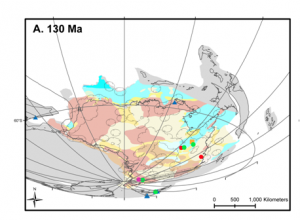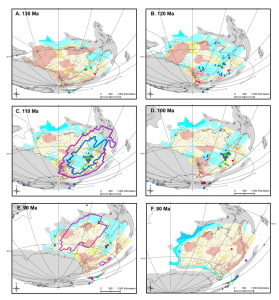 Summary
Summary
A variety of paleogeographic reconstructions have been published, with applications ranging from paleoclimate, ocean circulation and faunal radiation models to resource exploration; yet their uncertainties remain difficult to assess as they are generally presented as low-resolution static maps. We present a methodology for ground-truthing the digital Palaeogeographic Atlas of Australia by linking the GPlates plate reconstruction tool to the global Paleobiology Database and a Phanerozoic plate motion model.
We develop a spatio-temporal data mining workflow to validate the Phanerozoic Palaeogeographic Atlas of Australia with paleoenvironments derived from fossil data. While there is general agreement between fossil data and the paleogeographic atlas, the methodology highlights key inconsistencies. The Early Devonian paleogeographic model of southeastern Australia insufficiently describes the Emsian inundation that may be refined using biofacies distributions. Additionally, the paleogeographic model and fossil data can be used to strengthen numerical models, such as the dynamic topography and the associated inundation of eastern Australia during the Cretaceous. Although paleobiology data provide constraints only for paleoenvironments with high preservation potential of organisms, our approach enables the use of additional proxy data to generate improved paleogeographic reconstructions.
 Download
Download
The supplementary material contains a Phanerozoic plate motion model, digital coastline file, and continental outlines, ready for use with GPlates. This plate motion model is different from the Mesozoic and Cenozoic plate models by the EarthByte group, including models by Müller et al. (2008) and Seton et al. (2012). Instead, the Phanerozoic plate motion model accompanying this paper is based on the relative plate motions from Golonka (2007) and the updated absolute motions of Africa (using the GAD rotations) from Torsvik and Van Der Voo (2002). The complete Paleobiology Database (as of October 2011) is included in the supplementary material as tab delimited files, and the converted shapefiles are available for collections between 100 – 0 Ma. The Palaeogeographic Atlas of Australia is also provided in shapefile format, and has been converted into GTS2004. Additionally, the workflow and selected results from our data mining process is provided.
We also provide the complete Paleobiology Database collections for the entire Phanerozoic – zip file (as of October 2011) in shapefile format and cookie cut for use in GPlates.
Download the Phanerozoic plate motion model (Part 1 of the supplementary material) – zip file
Download a web quality movie of this model – m4v file
Download full quality movie of this model – mov file
Related articles
Open-access article
A post about this article on Geolog, the official blog of the EGU
Citation
Wright, N., Zahirovic, S., Müller, R. D., and Seton, M. Towards community-driven paleogeographic reconstructions: integrating open-access paleogeographic and paleobiology data with plate tectonics, Biogeosciences, 10, 1529-1541, doi:10.5194/bg-10-1529-2013, 2013.
Feedback
We welcome any feedback. Send email to Nicky Wright.
![]()
